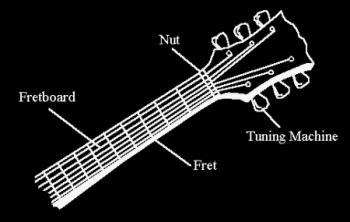Rhythm Lesson 1: The Basics
Practically the most frequent thing to be used and known on any guitar, is the fretboard "What is a fretboard?" you ask? To put it simply - It is the long neck of the guitar where lie various surface spaces in which you place your fingers to change the tone of the string you are plucking. To be exact, a "fret" is the actual bar after the space that you put your finger. That bar is what effects the tone the string makes when your finger is put down on the space behind it. Normally there are 22-24 frets on an electric and full size acoustic and 18-20 frets on a classical acoustic (with its shorter size). One of the most important things you can do as a starter is to get to know your way around it from fret to fret, from string to string, and how each relate to each other.

So the idea is, hold the pic in one hand, and put your fingers on the fretboard with the other. Pluck a string, not outward from the body, but downward, not hitting it too hard since force isn't really required. When you hit any string without any of your fingers being placed on the fretboard, it is known as hitting that string "open". Now you can change the tone of the string you are plucking by putting a finger on that string somewhere on the fretboard (on a finger spaces themselves, not the bars between them). Understand that the farther away from the Nut you press down, the higher the sound on the string you will hear. Furthermore, the lower and thinner the string is that you are on, the higher the tone you will hear as well (Assuming of course that all six strings are put on properly in order). Also, you will notice the dots on the fretboard. These, I like to think of landmarks for your fingers to know where they are and where they are going with. After all, I see the fretboard as a map that your fingers ride on. If there are dots on your fretboard, you will notice that they are placed on frets 3, 5, 7, 9, and 12 (where there is normally 2 dots to mark it is the high octave of all the notes on each string. After the 12th fret, all the frets after are ordered just like all the frets before, kind of like having 2 fretboards connected but the smaller one having all the higher octaves of the original one.
For the strings, think of the strings like this: Divide them into 2 sets of 3. The first (top) 3 are rhythm strings, heavily used for rhythm Power Chords and other chords. The bottom 3 could be known as lead strings, mostly used in solos. Overall, they're all used in common Chords and Barred Chords.
If you really want to get to know your fret board where you eventually see patterns appear in your head as you glance at the board, the best thing to do is dedicate yourself to learning cover songs. Knowing basic tunes first such as "Iron Man" and "Smoke on the Water" are perfect for getting introduced to basic and common patterns of notes. First you should learn things that are only on one string. Then through some practice at going from top string to next sting, you will eventually comfortably learn tunes that ride between 2 or more strings. I prefer "Enter Sandman" for this. Also there is one song that is not hardly ever though of as a starters song but actually uses very basic movement methods as well. Zakk Wylde's "Superterrorizor" uses the top two strings and can show you a pretty versatile set of notes.
Here's Tablature of "Iron Man". If you don't know how to read tablature, you can refer to the Guitar Glossary for information on how by clicking the "tablature" in white text.

The point of this lesson being, the best way to know your fret board is to let the other band's songs show you. The best thing you can do is constantly use cover songs to practice and open your mind to the world of patterns on the fret board.
Back to Lesson Menu Next Lesson